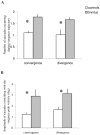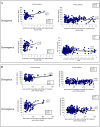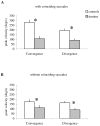Central crosstalk for somatic tinnitus: abnormal vergence eye movements
- PMID: 20676372
- PMCID: PMC2911381
- DOI: 10.1371/journal.pone.0011845
Central crosstalk for somatic tinnitus: abnormal vergence eye movements
Abstract
Background: Frequent oulomotricity problems with orthoptic testing were reported in patients with tinnitus. This study examines with objective recordings vergence eye movements in patients with somatic tinnitus patients with ability to modify their subjective tinnitus percept by various movements, such as jaw, neck, eye movements or skin pressure.
Methods: Vergence eye movements were recorded with the Eyelink II video system in 15 (23-63 years) control adults and 19 (36-62 years) subjects with somatic tinnitus.
Findings: 1) Accuracy of divergence but not of convergence was lower in subjects with somatic tinnitus than in control subjects. 2) Vergence duration was longer and peak velocity was lower in subjects with somatic tinnitus than in control subjects. 3) The number of embedded saccades and the amplitude of saccades coinciding with the peak velocity of vergence were higher for tinnitus subjects. Yet, saccades did not increase peak velocity of vergence for tinnitus subjects, but they did so for controls. 4) In contrast, there was no significant difference of vergence latency between these two groups.
Interpretation: The results suggest dysfunction of vergence areas involving cortical-brainstem-cerebellar circuits. We hypothesize that central auditory dysfunction related to tinnitus percept could trigger mild cerebellar-brainstem dysfunction or that tinnitus and vergence dysfunction could both be manifestations of mild cortical-brainstem-cerebellar syndrome reflecting abnormal cross-modality interactions between vergence eye movements and auditory signals.
Conflict of interest statement
Figures











Similar articles
-
Speed-accuracy of saccades, vergence and combined eye movements in children with vertigo.Exp Brain Res. 2004 Aug;157(3):286-95. doi: 10.1007/s00221-004-1842-0. Epub 2004 Mar 13. Exp Brain Res. 2004. PMID: 15024539
-
Saccade-vergence dynamics and interaction in children and in adults.Exp Brain Res. 2004 May;156(2):212-23. doi: 10.1007/s00221-003-1773-1. Exp Brain Res. 2004. PMID: 15344851
-
Saccades and vergence performance in a population of children with vertigo and clinically assessed abnormal vergence capabilities.PLoS One. 2011;6(8):e23125. doi: 10.1371/journal.pone.0023125. Epub 2011 Aug 9. PLoS One. 2011. PMID: 21858007 Free PMC article. Clinical Trial.
-
Neuronal circuitry controlling the near response.Curr Opin Neurobiol. 1995 Dec;5(6):763-8. doi: 10.1016/0959-4388(95)80104-9. Curr Opin Neurobiol. 1995. PMID: 8805411 Review.
-
Somatosensory tinnitus: Current evidence and future perspectives.J Int Med Res. 2017 Jun;45(3):933-947. doi: 10.1177/0300060517707673. Epub 2017 May 28. J Int Med Res. 2017. PMID: 28553764 Free PMC article. Review.
Cited by
-
Objective Evaluation of Vergence Disorders and a Research-Based Novel Method for Vergence Rehabilitation.Transl Vis Sci Technol. 2016 Mar 11;5(2):8. doi: 10.1167/tvst.5.2.8. eCollection 2016 Mar. Transl Vis Sci Technol. 2016. PMID: 26981330 Free PMC article.
-
Differential auditory-oculomotor interactions in patients with right vs. left sided subjective tinnitus: a saccade study.Front Hum Neurosci. 2013 Feb 26;7:47. doi: 10.3389/fnhum.2013.00047. eCollection 2013. Front Hum Neurosci. 2013. PMID: 23550269 Free PMC article.
-
Frontal eye field, where art thou? Anatomy, function, and non-invasive manipulation of frontal regions involved in eye movements and associated cognitive operations.Front Integr Neurosci. 2014 Aug 22;8:66. doi: 10.3389/fnint.2014.00066. eCollection 2014. Front Integr Neurosci. 2014. PMID: 25202241 Free PMC article. Review.
References
-
- Eggermont JJ, Roberts LE. The neuroscience of tinnitus. Trends Neurosci. 2004;27:676–682. - PubMed
-
- Norena A, Micheyl C, Chery-Croze S, Collet L. Psychoacoustic characterization of the tinnitus spectrum: implications for the underlying mechanisms of tinnitus. Audiol Neurootol. 2002;7:358–369. - PubMed
-
- Levine RA, Abel M, Cheng H. CNS somatosensory-auditory interactions elicit or modulate tinnitus. Exp Brain Res. 2003;153:643–648. - PubMed
-
- Kapoula Z, Yang Q, Vernet M, Bonfils P, Londero A. Eye movement abnormalities in somatic tinnitus: Fixation, smooth pursuit and optokinetic nystagmus. Auris Nasus Larynx 2009 - PubMed
-
- Jozefowicz-Korczynska M, Pajor A. Evaluation of oculomotor tests in patients with tinnitus. Int Tinnitus J. 2002;8:100–103. - PubMed
MeSH terms
LinkOut - more resources
Full Text Sources
Medical

